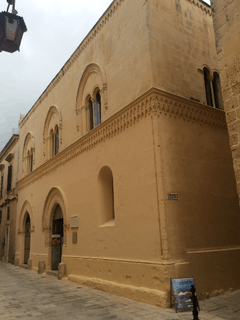Palazzo Falson
| Palazzo Falson | |
|---|---|
 | |
 Façade of Palazzo Falson | |
| Alternative names |
Palazzo Falzon Palazzo Cumbo-Navarra Norman House |
| General information | |
| Status | Intact |
| Type | Palace |
| Architectural style | Medieval |
| Location | Mdina, Malta |
| Coordinates | 35°53′13.2″N 14°24′11.2″E / 35.887000°N 14.403111°E |
| Current tenants | Fondazzjoni Patrimonju Malti |
| Construction started | c. 1495[lower-alpha 1] |
| Completed | 16th century |
| Renovated | 1929 |
| Owner | The Captain O. F. Gollcher OBE Art and Archaeological Foundation |
| Technical details | |
| Material | Limestone |
| Floor count | 2 |
| Website | |
| www.palazzofalson.com | |
Palazzo Falson (or Falzon), also known as Palazzo Cumbo-Navarra or the Norman House and Casa dei Castelletti,[1] is a palace in Mdina, Malta. It is believed to have been constructed between around 1495 and mid-16th century, although parts of it might date back to the 13th century. This makes it the second oldest building in the city, after Palazzo Santa Sofia. The palace is now open to the public as the Palazzo Falson Historic House Museum.
History
The site of Palazzo Falson was originally occupied by a building known as La Rocca. By the 13th century, a single story house had been built, and eventually a synagogue stood on the site.[2] According to the architect Quentin Hughes, the ground floor and façade of the present palace were built in around 1495, possibly incorporating parts of the synagogue. The palace's piano nobile is believed to have been added in the mid-16th century.[3]
According to tradition, the palace was visited by Grand Master Philippe Villiers de L'Isle-Adam on 13 November 1530 for a banquet, after the ceremony in which he took possession of Mdina. L'Isle-Adam's visit to the Falsone residence in Mdina is documented by Giovanni Francesco Abela in his 1647 book Della Descrittione di Malta, and until recently, the residence in question was assumed to be Palazzo Falson. However, there is no evidence that the main branch of the Falsone family actually resided at Palazzo Falson, and it is now known that the palace originally belonged to the Cumbo family.[4]
In 1657, the palace belonged to Ugolino Cumbo Navarra, and on his death it was inherited by his aunt Guzmana Cassar. She passed the building to Federico Falsone (her nephew[5]), but it is believed that he never actually lived there. The palace eventually passed into the hands of the Muscati-Falsone-Navarra family, and by the 1920s it belonged to Count Francesco Palermo Navarra Bonici, a resident of Catania.[4]
In 1927, Olof Frederick Gollcher OBE purchased part of the palace from Count Navarra Bonici for £680, and he later bought remaining part of the palace in 1938 for £550. Gollcher was an art collector, and he transferred his collections into the palace, which he called The Norman House since at the time its architectural features were considered to be Siculo-Norman.[2] In 1929, the palace's façade was restored, but it was also modified in the process. Parts of the interior were also altered.[3] Gollcher died in 1962, and five years later the palace passed into the hands of The Captain O. F. Gollcher OBE Art and Archaeological Foundation, which was set up according to Gollcher's will.[6]
In 2001, the Gollcher Foundation entered in an agreement with Fondazzjoni Patrimonju Malti, allowing it to manage the palace and transform it into a museum.[7] The foundation restored the palace, and since May 2007, it has been open to the public as the Palazzo Falson Historic House Museum.[6] The palace is scheduled as a Grade 1 national monument, and it is also listed in the National Inventory of the Cultural Property of the Maltese Islands.[3]
Architecture


Palazzo Falson has two stories, and it is built around a central courtyard. The ground floor is built in a vernacular style, possibly incorporating part of an earlier synagogue. The piano nobile is more ornate. The façade has Spanish influences, having a number of mullioned windows in the Catalan style. A two-tiered palline losanghe cornice separates the ground floor from the first floor, while a similar cornice but with a single tier is located at roof level.[3] These cornices are similar to those found at Palazzo Santa Sofia in Mdina and Palazzo Montalto in Syracuse.[4]
Further reading
References
- ↑ Zammit, Andre (2009), "200-year-old History in an old musty archive". The Malta Independent. Retrieved February 22, 2016.
- 1 2 "History". Palazzo Falson Historic House Museum. Archived from the original on 18 January 2016.
- 1 2 3 4 "Palazzo Falzon and Garden" (PDF). National Inventory of the Cultural Property of the Maltese Islands. 28 December 2012. Archived from the original (PDF) on 18 January 2016.
- 1 2 3 Busuttil, Claude (1999). "A Double Act for the 'Norman House': Palazzo Falzon or Palazzo Cumbo-Navarra?" (PDF). Melita Historica. 12 (4): 411–418. Archived from the original (PDF) on 18 January 2016.
- ↑ 1869, "Collectio omnium conclusionum et resolutionum quae in causis propositis apud sacram congregationem cardinalium S. Concilii Tridentini interpretum prodierunt ab ejus institutione, Salvator Pallottini", typis Sacrae congregationis de propaganda fide, Lyon Public Library (Bibliothèque jésuite des Fontaines), p. 90.
- 1 2 "Palazzo Falson Historic House Museum, Mdina". Fondazzjoni Patrimonju Malti. Archived from the original on 18 January 2016.
- ↑ "Museums". Fondazzjoni Patrimonju Malti. Archived from the original on 18 June 2015.
Notes
- ↑ Some parts of the building might date back to the 13th century.
External links
| Wikimedia Commons has media related to Palazzo Falson. |